Java8中CompletableFuture的用法全解
目录
- 前言
- 一、创建异步任务
- 1、Future.submit
- 2、supplyAsync / runAsync
- 二、异步回调
- 1、thenApply / thenApplyAsync
- 2、thenAccept / thenRun
- 3、 exceptionally
- 4、whenComplete
- 5、handle
- 三、组合处理
- 1、thenCombine / thenAcceptBoth / runAfterBoth
- 2、applyToEither / acceptEither / runAfterEither
- 3、thenCompose
- 4、allOf / anyOf
- 总结
前言
CompletableFuture实现了CompletionStage接口和Future接口,前者是对后者的一个扩展,增加了异步回调、流式处理、多个Future组合处理的能力,使Java在处理多任务的协同工作时更加顺畅便利。
一、创建异步任务
1、Future.submit
通常的线程池接口类ExecutorService,其中execute方法的返回值是void,即无法获取异步任务的执行状态,3个重载的submit方法的返回值是Future,可以据此获取任务执行的状态和结果,示例如下:
@Test
public void test3() throws Exception {
// 创建异步执行任务:
ExecutorService executorService= Executors.newSingleThreadExecutor();
Future<Double> cf = executorService.submit(()->{
System.out.println(Thread.currentThread()+" start,time->"+System.currentTimeMillis());
try {
Thread.sleep(2000);
} catch (InterruptedException e) {
}
if(false){
throw new RuntimeException("test");
}else{
System.out.println(Thread.currentThread()+" exit,time->"+System.currentTimeMillis());
return 1.2;
}
});
System.out.println("main thread start,time->"+System.currentTimeMillis());
//等待子任务执行完成,如果已完成则直接返回结果
//如果执行任务异常,则get方法会把之前捕获的异常重新抛出
System.out.println("run result->"+cf.get());
System.out.println("main thread exit,time->"+System.currentTimeMillis());
}
执行结果如下:

子线程是异步执行的,主线程休眠等待子线程执行完成,子线程执行完成后唤醒主线程,主线程获取任务执行结果后退出。
很多博客说使用不带等待时间限制的get方法时,如果子线程执行异常了会导致主线程长期阻塞,这其实是错误的,子线程执行异常时其异常会被捕获,然后修改任务的状态为异常结束并唤醒等待的主线程,get方法判断任务状态发生变更,就终止等待了,并抛出异常,可参考《Java8 AbstractExecutorService 和 FutureTask 源码解析》中FutureTask的实现。将上述用例中if(false)改成if(true) ,执行结果如下:

get方法抛出异常导致主线程异常终止。
2、supplyAsync / runAsync
supplyAsync表示创建带返回值的异步任务的,相当于ExecutorService submit(Callable<T> task) 方法,runAsync表示创建无返回值的异步任务,相当于ExecutorService submit(Runnable task)方法,这两方法的效果跟submit是一样的,测试用例如下:
@Test
public void test2() throws Exception {
// 创建异步执行任务,有返回值
CompletableFuture<Double> cf = CompletableFuture.supplyAsync(()->{
System.out.println(Thread.currentThread()+" start,time->"+System.currentTimeMillis());
try {
Thread.sleep(2000);
} catch (InterruptedException e) {
}
if(true){
throw new RuntimeException("test");
}else{
System.out.println(Thread.currentThread()+" exit,time->"+System.currentTimeMillis());
return 1.2;
}
});
System.out.println("main thread start,time->"+System.currentTimeMillis());
//等待子任务执行完成
System.out.println("run result->"+cf.get());
System.out.println("main thread exit,time->"+System.currentTimeMillis());
}
@Test
public void test4() throws Exception {
// 创建异步执行任务,无返回值
CompletableFuture cf = CompletableFuture.runAsync(()->{
System.out.println(Thread.currentThread()+" start,time->"+System.currentTimeMillis());
try {
Thread.sleep(2000);
} catch (InterruptedException e) {
}
if(false){
throw new RuntimeException("test");
}else{
System.out.println(Thread.currentThread()+" exit,time->"+System.currentTimeMillis());
}
});
System.out.println("main thread start,time->"+System.currentTimeMillis());
//等待子任务执行完成
System.out.println("run result->"+cf.get());
System.out.println("main thread exit,time->"+System.currentTimeMillis());
}
这两方法各有一个重载版本,可以指定执行异步任务的Executor实现,如果不指定,默认使用ForkJoinPool.commonPool(),如果机器是单核的,则默认使用ThreadPerTaskExecutor,该类是一个内部类,每次执行execute都会创建一个新线程。测试用例如下:
@Test
public void test2() throws Exception {
ForkJoinPool pool=new ForkJoinPool();
// 创建异步执行任务:
CompletableFuture<Double> cf = CompletableFuture.supplyAsync(()->{
System.out.println(Thread.currentThread()+" start,time->"+System.currentTimeMillis());
try {
Thread.sleep(2000);
} catch (InterruptedException e) {
}
if(true){
throw new RuntimeException("test");
}else{
System.out.println(Thread.currentThread()+" exit,time->"+System.currentTimeMillis());
return 1.2;
}
},pool);
System.out.println("main thread start,time->"+System.currentTimeMillis());
//等待子任务执行完成
System.out.println("run result->"+cf.get());
System.out.println("main thread exit,time->"+System.currentTimeMillis());
}
@Test
public void test4() throws Exception {
ExecutorService executorService= Executors.newSingleThreadExecutor();
// 创建异步执行任务:
CompletableFuture cf = CompletableFuture.runAsync(()->{
System.out.println(Thread.currentThread()+" start,time->"+System.currentTimeMillis());
try {
Thread.sleep(2000);
} catch (InterruptedException e) {
}
if(false){
throw new RuntimeException("test");
}else{
System.out.println(Thread.currentThread()+" exit,time->"+System.currentTimeMillis());
}
},executorService);
System.out.println("main thread start,time->"+System.currentTimeMillis());
//等待子任务执行完成
System.out.println("run result->"+cf.get());
System.out.println("main thread exit,time->"+System.currentTimeMillis());
}
二、异步回调
1、thenApply / thenApplyAsync
thenApply 表示某个任务执行完成后执行的动作,即回调方法,会将该任务的执行结果即方法返回值作为入参传递到回调方法中,测试用例如下:
@Test
public void test5() throws Exception {
ForkJoinPool pool=new ForkJoinPool();
// 创建异步执行任务:
CompletableFuture<Double> cf = CompletableFuture.supplyAsync(()->{
System.out.println(Thread.currentThread()+" start job1,time->"+System.currentTimeMillis());
try {
Thread.sleep(2000);
} catch (InterruptedException e) {
}
System.out.println(Thread.currentThread()+" exit job1,time->"+System.currentTimeMillis());
return 1.2;
},pool);
//cf关联的异步任务的返回值作为方法入参,传入到thenApply的方法中
//thenApply这里实际创建了一个新的CompletableFuture实例
CompletableFuture<String> cf2=cf.thenApply((result)->{
System.out.println(Thread.currentThread()+" start job2,time->"+System.currentTimeMillis());
try {
Thread.sleep(2000);
} catch (InterruptedException e) {
}
System.out.println(Thread.currentThread()+" exit job2,time->"+System.currentTimeMillis());
return "test:"+result;
});
System.out.println("main thread start cf.get(),time->"+System.currentTimeMillis());
//等待子任务执行完成
System.out.println("run result->"+cf.get());
System.out.println("main thread start cf2.get(),time->"+System.currentTimeMillis());
System.out.println("run result->"+cf2.get());
System.out.println("main thread exit,time->"+System.currentTimeMillis());
}
其执行结果如下:
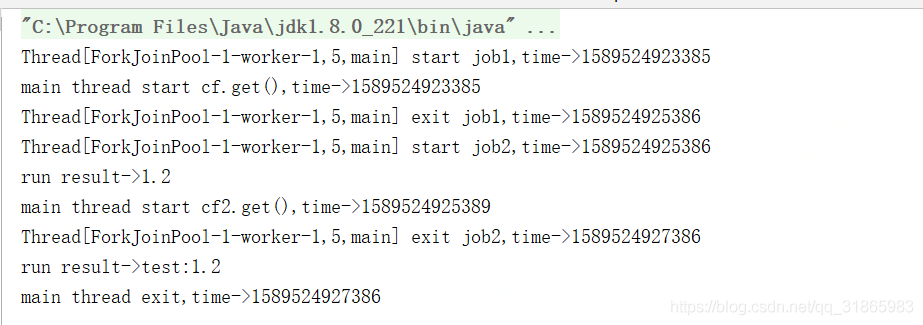
job1执行结束后,将job1的方法返回值作为入参传递到job2中并立即执行job2。thenApplyAsync与thenApply的区别在于,前者是将job2提交到线程池中异步执行,实际执行job2的线程可能是另外一个线程,后者是由执行job1的线程立即执行job2,即两个job都是同一个线程执行的。将上述测试用例中thenApply改成thenApplyAsync后,执行结果如下:
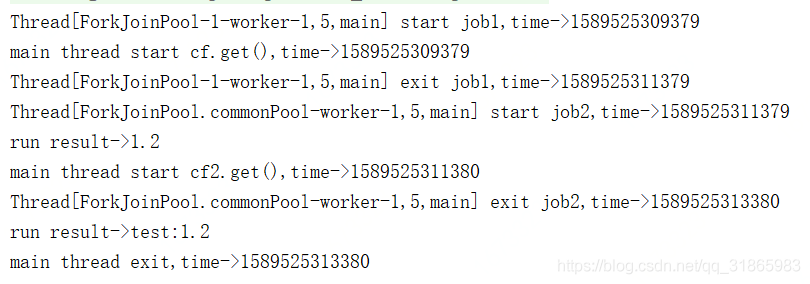
从输出可知,执行job1和job2是两个不同的线程。thenApplyAsync有一个重载版本,可以指定执行异步任务的Executor实现,如果不指定,默认使用ForkJoinPool.commonPool()。 下述的多个方法,每个方法都有两个以Async结尾的方法,一个使用默认的Executor实现,一个使用指定的Executor实现,不带Async的方法是由触发该任务的线程执行该任务,带Async的方法是由触发该任务的线程将任务提交到线程池,执行任务的线程跟触发任务的线程不一定是同一个。
2、thenAccept / thenRun
thenAccept 同 thenApply 接收上一个任务的返回值作为参数,但是无返回值;thenRun 的方法没有入参,也买有返回值,测试用例如下:
@Test
public void test6() throws Exception {
ForkJoinPool pool=new ForkJoinPool();
// 创建异步执行任务:
CompletableFuture<Double> cf = CompletableFuture.supplyAsync(()->{
System.out.println(Thread.currentThread()+" start job1,time->"+System.currentTimeMillis());
try {
Thread.sleep(2000);
} catch (InterruptedException e) {
}
System.out.println(Thread.currentThread()+" exit job1,time->"+System.currentTimeMillis());
return 1.2;
},pool);
//cf关联的异步任务的返回值作为方法入参,传入到thenApply的方法中
CompletableFuture cf2=cf.thenApply((result)->{
System.out.println(Thread.currentThread()+" start job2,time->"+System.currentTimeMillis());
try {
Thread.sleep(2000);
} catch (InterruptedException e) {
}
System.out.println(Thread.currentThread()+" exit job2,time->"+System.currentTimeMillis());
return "test:"+result;
}).thenAccept((result)-> { //接收上一个任务的执行结果作为入参,但是没有返回值
System.out.println(Thread.currentThread()+" start job3,time->"+System.currentTimeMillis());
try {
Thread.sleep(2000);
} catch (InterruptedException e) {
}
System.out.println(result);
System.out.println(Thread.currentThread()+" exit job3,time->"+System.currentTimeMillis());
}).thenRun(()->{ //无入参,也没有返回值
System.out.println(Thread.currentThread()+" start job4,time->"+System.currentTimeMillis());
try {
Thread.sleep(2000);
} catch (InterruptedException e) {
}
System.out.println("thenRun do something");
System.out.println(Thread.currentThread()+" exit job4,time->"+System.currentTimeMillis());
});
System.out.println("main thread start cf.get(),time->"+System.currentTimeMillis());
//等待子任务执行完成
System.out.println("run result->"+cf.get());
System.out.println("main thread start cf2.get(),time->"+System.currentTimeMillis());
//cf2 等待最后一个thenRun执行完成
System.out.println("run result->"+cf2.get());
System.out.println("main thread exit,time->"+System.currentTimeMillis());
}
其执行结果如下:

3、 exceptionally
exceptionally方法指定某个任务执行异常时执行的回调方法,会将抛出异常作为参数传递到回调方法中,如果该任务正常执行则会exceptionally方法返回的CompletionStage的result就是该任务正常执行的结果,测试用例如下:
@Test
public void test2() throws Exception {
ForkJoinPool pool=new ForkJoinPool();
// 创建异步执行任务:
CompletableFuture<Double> cf = CompletableFuture.supplyAsync(()->{
System.out.println(Thread.currentThread()+"job1 start,time->"+System.currentTimeMillis());
try {
Thread.sleep(2000);
} catch (InterruptedException e) {
}
if(true){
throw new RuntimeException("test");
}else{
System.out.println(Thread.currentThread()+"job1 exit,time->"+System.currentTimeMillis());
return 1.2;
}
},pool);
//cf执行异常时,将抛出的异常作为入参传递给回调方法
CompletableFuture<Double> cf2= cf.exceptionally((param)->{
System.out.println(Thread.currentThread()+" start,time->"+System.currentTimeMillis());
try {
Thread.sleep(2000);
} catch (InterruptedException e) {
}
System.out.println("error stack trace->");
param.printStackTrace();
System.out.println(Thread.currentThread()+" exit,time->"+System.currentTimeMillis());
return -1.1;
});
//cf正常执行时执行的逻辑,如果执行异常则不调用此逻辑
CompletableFuture cf3=cf.thenAccept((param)->{
System.out.println(Thread.currentThread()+"job2 start,time->"+System.currentTimeMillis());
try {
Thread.sleep(2000);
} catch (InterruptedException e) {
}
System.out.println("param->"+param);
System.out.println(Thread.currentThread()+"job2 exit,time->"+System.currentTimeMillis());
});
System.out.println("main thread start,time->"+System.currentTimeMillis());
//等待子任务执行完成,此处无论是job2和job3都可以实现job2退出,主线程才退出,如果是cf,则主线程不会等待job2执行完成自动退出了
//cf2.get时,没有异常,但是依然有返回值,就是cf的返回值
System.out.println("run result->"+cf2.get());
System.out.println("main thread exit,time->"+System.currentTimeMillis());
}
其输出如下:
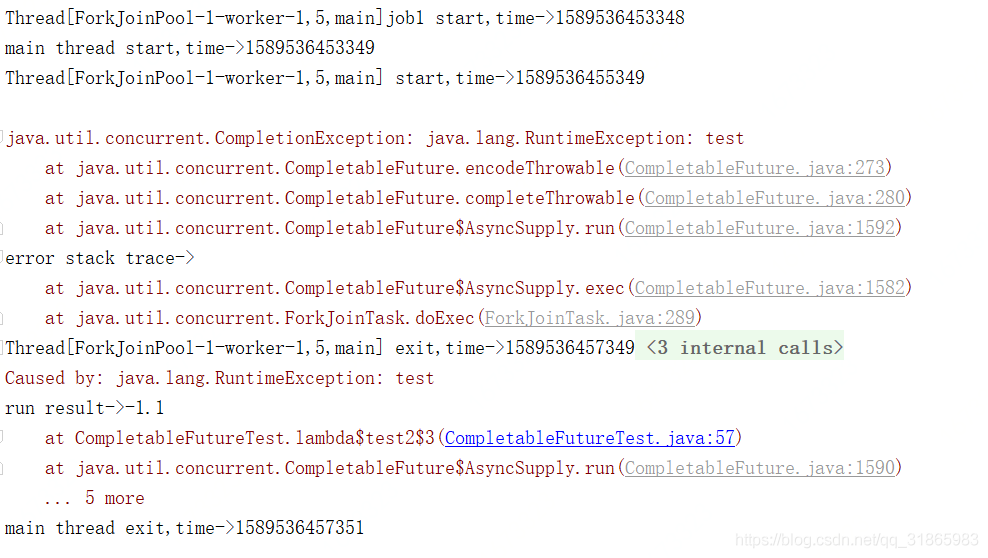
抛出异常后,只有cf2执行了,cf3没有执行。将上述示例中的if(true) 改成if(false),其输出如下:
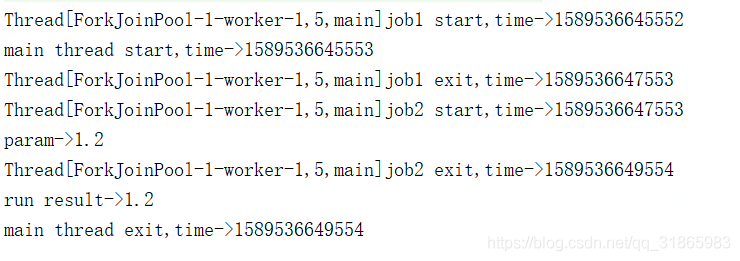
cf2没有指定,其result就是cf执行的结果,理论上cf2.get应该立即返回的,此处是等待了cf3,即job2执行完成后才返回,具体原因且待下篇源码分析时再做探讨。
4、whenComplete
whenComplete是当某个任务执行完成后执行的回调方法,会将执行结果或者执行期间抛出的异常传递给回调方法,如果是正常执行则异常为null,回调方法对应的CompletableFuture的result和该任务一致,如果该任务正常执行,则get方法返回执行结果,如果是执行异常,则get方法抛出异常。测试用例如下:
@Test
public void test10() throws Exception {
// 创建异步执行任务:
CompletableFuture<Double> cf = CompletableFuture.supplyAsync(()->{
System.out.println(Thread.currentThread()+"job1 start,time->"+System.currentTimeMillis());
try {
Thread.sleep(2000);
} catch (InterruptedException e) {
}
if(false){
throw new RuntimeException("test");
}else{
System.out.println(Thread.currentThread()+"job1 exit,time->"+System.currentTimeMillis());
return 1.2;
}
});
//cf执行完成后会将执行结果和执行过程中抛出的异常传入回调方法,如果是正常执行的则传入的异常为null
CompletableFuture<Double> cf2=cf.whenComplete((a,b)->{
System.out.println(Thread.currentThread()+"job2 start,time->"+System.currentTimeMillis());
try {
Thread.sleep(2000);
} catch (InterruptedException e) {
}
if(b!=null){
System.out.println("error stack trace->");
b.printStackTrace();
}else{
System.out.println("run succ,result->"+a);
}
System.out.println(Thread.currentThread()+"job2 exit,time->"+System.currentTimeMillis());
});
//等待子任务执行完成
System.out.println("main thread start wait,time->"+System.currentTimeMillis());
//如果cf是正常执行的,cf2.get的结果就是cf执行的结果
//如果cf是执行异常,则cf2.get会抛出异常
System.out.println("run result->"+cf2.get());
System.out.println("main thread exit,time->"+System.currentTimeMillis());
}
执行结果如下:

将上述示例中的if(false) 改成if(true),其输出如下:

5、handle
跟whenComplete基本一致,区别在于handle的回调方法有返回值,且handle方法返回的CompletableFuture的result是回调方法的执行结果或者回调方法执行期间抛出的异常,与原始CompletableFuture的result无关了。测试用例如下:
@Test
public void test10() throws Exception {
// 创建异步执行任务:
CompletableFuture<Double> cf = CompletableFuture.supplyAsync(()->{
System.out.println(Thread.currentThread()+"job1 start,time->"+System.currentTimeMillis());
try {
Thread.sleep(2000);
} catch (InterruptedException e) {
}
if(true){
throw new RuntimeException("test");
}else{
System.out.println(Thread.currentThread()+"job1 exit,time->"+System.currentTimeMillis());
return 1.2;
}
});
//cf执行完成后会将执行结果和执行过程中抛出的异常传入回调方法,如果是正常执行的则传入的异常为null
CompletableFuture<String> cf2=cf.handle((a,b)->{
System.out.println(Thread.currentThread()+"job2 start,time->"+System.currentTimeMillis());
try {
Thread.sleep(2000);
} catch (InterruptedException e) {
}
if(b!=null){
System.out.println("error stack trace->");
b.printStackTrace();
}else{
System.out.println("run succ,result->"+a);
}
System.out.println(Thread.currentThread()+"job2 exit,time->"+System.currentTimeMillis());
if(b!=null){
return "run error";
}else{
return "run succ";
}
});
//等待子任务执行完成
System.out.println("main thread start wait,time->"+System.currentTimeMillis());
//get的结果是cf2的返回值,跟cf没关系了
System.out.println("run result->"+cf2.get());
System.out.println("main thread exit,time->"+System.currentTimeMillis());
}
其执行结果如下:

将上述示例中的if(true) 改成if(false),其输出如下:

三、组合处理
1、thenCombine / thenAcceptBoth / runAfterBoth
这三个方法都是将两个CompletableFuture组合起来,只有这两个都正常执行完了才会执行某个任务,区别在于,thenCombine会将两个任务的执行结果作为方法入参传递到指定方法中,且该方法有返回值;thenAcceptBoth同样将两个任务的执行结果作为方法入参,但是无返回值;runAfterBoth没有入参,也没有返回值。注意两个任务中只要有一个执行异常,则将该异常信息作为指定任务的执行结果。测试用例如下:
@Test
public void test7() throws Exception {
ForkJoinPool pool=new ForkJoinPool();
// 创建异步执行任务:
CompletableFuture<Double> cf = CompletableFuture.supplyAsync(()->{
System.out.println(Thread.currentThread()+" start job1,time->"+System.currentTimeMillis());
try {
Thread.sleep(2000);
} catch (InterruptedException e) {
}
System.out.println(Thread.currentThread()+" exit job1,time->"+System.currentTimeMillis());
return 1.2;
});
CompletableFuture<Double> cf2 = CompletableFuture.supplyAsync(()->{
System.out.println(Thread.currentThread()+" start job2,time->"+System.currentTimeMillis());
try {
Thread.sleep(1500);
} catch (InterruptedException e) {
}
System.out.println(Thread.currentThread()+" exit job2,time->"+System.currentTimeMillis());
return 3.2;
});
//cf和cf2的异步任务都执行完成后,会将其执行结果作为方法入参传递给cf3,且有返回值
CompletableFuture<Double> cf3=cf.thenCombine(cf2,(a,b)->{
System.out.println(Thread.currentThread()+" start job3,time->"+System.currentTimeMillis());
System.out.println("job3 param a->"+a+",b->"+b);
try {
Thread.sleep(2000);
} catch (InterruptedException e) {
}
System.out.println(Thread.currentThread()+" exit job3,time->"+System.currentTimeMillis());
return a+b;
});
//cf和cf2的异步任务都执行完成后,会将其执行结果作为方法入参传递给cf3,无返回值
CompletableFuture cf4=cf.thenAcceptBoth(cf2,(a,b)->{
System.out.println(Thread.currentThread()+" start job4,time->"+System.currentTimeMillis());
System.out.println("job4 param a->"+a+",b->"+b);
try {
Thread.sleep(1500);
} catch (InterruptedException e) {
}
System.out.println(Thread.currentThread()+" exit job4,time->"+System.currentTimeMillis());
});
//cf4和cf3都执行完成后,执行cf5,无入参,无返回值
CompletableFuture cf5=cf4.runAfterBoth(cf3,()->{
System.out.println(Thread.currentThread()+" start job5,time->"+System.currentTimeMillis());
try {
Thread.sleep(1000);
} catch (InterruptedException e) {
}
System.out.println("cf5 do something");
System.out.println(Thread.currentThread()+" exit job5,time->"+System.currentTimeMillis());
});
System.out.println("main thread start cf.get(),time->"+System.currentTimeMillis());
//等待子任务执行完成
System.out.println("cf run result->"+cf.get());
System.out.println("main thread start cf5.get(),time->"+System.currentTimeMillis());
System.out.println("cf5 run result->"+cf5.get());
System.out.println("main thread exit,time->"+System.currentTimeMillis());
}
其运行结果如下:
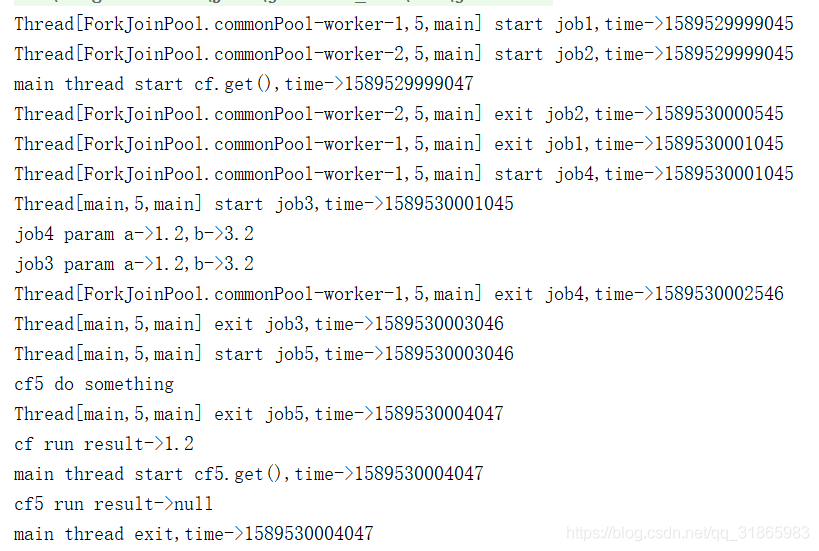
job1 和 job2几乎同时运行,job2比job1先执行完成,等job1退出后,job3和job4几乎同时开始运行,job4先退出,等job3执行完成,job5开始了,等job5执行完成后,主线程退出。
2、applyToEither / acceptEither / runAfterEither
这三个方法都是将两个CompletableFuture组合起来,只要其中一个执行完了就会执行某个任务,其区别在于applyToEither会将已经执行完成的任务的执行结果作为方法入参,并有返回值;acceptEither同样将已经执行完成的任务的执行结果作为方法入参,但是没有返回值;runAfterEither没有方法入参,也没有返回值。注意两个任务中只要有一个执行异常,则将该异常信息作为指定任务的执行结果。测试用例如下:
@Test
public void test8() throws Exception {
// 创建异步执行任务:
CompletableFuture<Double> cf = CompletableFuture.supplyAsync(()->{
System.out.println(Thread.currentThread()+" start job1,time->"+System.currentTimeMillis());
try {
Thread.sleep(2000);
} catch (InterruptedException e) {
}
System.out.println(Thread.currentThread()+" exit job1,time->"+System.currentTimeMillis());
return 1.2;
});
CompletableFuture<Double> cf2 = CompletableFuture.supplyAsync(()->{
System.out.println(Thread.currentThread()+" start job2,time->"+System.currentTimeMillis());
try {
Thread.sleep(1500);
} catch (InterruptedException e) {
}
System.out.println(Thread.currentThread()+" exit job2,time->"+System.currentTimeMillis());
return 3.2;
});
//cf和cf2的异步任务都执行完成后,会将其执行结果作为方法入参传递给cf3,且有返回值
CompletableFuture<Double> cf3=cf.applyToEither(cf2,(result)->{
System.out.println(Thread.currentThread()+" start job3,time->"+System.currentTimeMillis());
System.out.println("job3 param result->"+result);
try {
Thread.sleep(2000);
} catch (InterruptedException e) {
}
System.out.println(Thread.currentThread()+" exit job3,time->"+System.currentTimeMillis());
return result;
});
//cf和cf2的异步任务都执行完成后,会将其执行结果作为方法入参传递给cf3,无返回值
CompletableFuture cf4=cf.acceptEither(cf2,(result)->{
System.out.println(Thread.currentThread()+" start job4,time->"+System.currentTimeMillis());
System.out.println("job4 param result->"+result);
try {
Thread.sleep(1500);
} catch (InterruptedException e) {
}
System.out.println(Thread.currentThread()+" exit job4,time->"+System.currentTimeMillis());
});
//cf4和cf3都执行完成后,执行cf5,无入参,无返回值
CompletableFuture cf5=cf4.runAfterEither(cf3,()->{
System.out.println(Thread.currentThread()+" start job5,time->"+System.currentTimeMillis());
try {
Thread.sleep(1000);
} catch (InterruptedException e) {
}
System.out.println("cf5 do something");
System.out.println(Thread.currentThread()+" exit job5,time->"+System.currentTimeMillis());
});
System.out.println("main thread start cf.get(),time->"+System.currentTimeMillis());
//等待子任务执行完成
System.out.println("cf run result->"+cf.get());
System.out.println("main thread start cf5.get(),time->"+System.currentTimeMillis());
System.out.println("cf5 run result->"+cf5.get());
System.out.println("main thread exit,time->"+System.currentTimeMillis());
}
其运行结果如下:
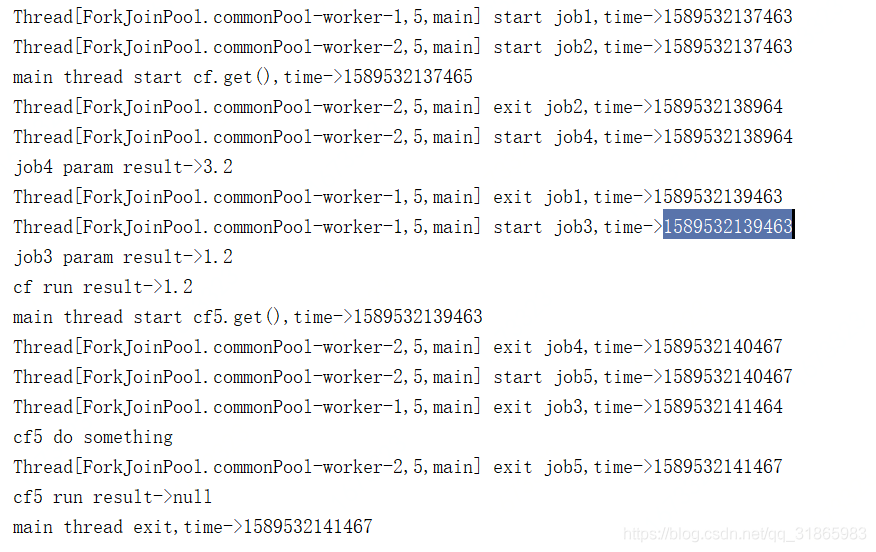
job1 和job2 同时开始运行,job2先执行完成,然后job4开始执行,理论上job3和job4应该同时开始运行,但是此时只有job4开始执行了,job3是等待job1执行完成后才开始执行,job4先于job3执行完成,然后job5开始执行,等job5执行完成后,主线程退出。上述差异且到下篇源码分析时再做探讨。
3、thenCompose
thenCompose方法会在某个任务执行完成后,将该任务的执行结果作为方法入参然后执行指定的方法,该方法会返回一个新的CompletableFuture实例,如果该CompletableFuture实例的result不为null,则返回一个基于该result的新的CompletableFuture实例;如果该CompletableFuture实例为null,则,然后执行这个新任务,测试用例如下:
@Test
public void test9() throws Exception {
// 创建异步执行任务:
CompletableFuture<Double> cf = CompletableFuture.supplyAsync(()->{
System.out.println(Thread.currentThread()+" start job1,time->"+System.currentTimeMillis());
try {
Thread.sleep(2000);
} catch (InterruptedException e) {
}
System.out.println(Thread.currentThread()+" exit job1,time->"+System.currentTimeMillis());
return 1.2;
});
CompletableFuture<String> cf2= cf.thenCompose((param)->{
System.out.println(Thread.currentThread()+" start job2,time->"+System.currentTimeMillis());
try {
Thread.sleep(2000);
} catch (InterruptedException e) {
}
System.out.println(Thread.currentThread()+" exit job2,time->"+System.currentTimeMillis());
return CompletableFuture.supplyAsync(()->{
System.out.println(Thread.currentThread()+" start job3,time->"+System.currentTimeMillis());
try {
Thread.sleep(2000);
} catch (InterruptedException e) {
}
System.out.println(Thread.currentThread()+" exit job3,time->"+System.currentTimeMillis());
return "job3 test";
});
});
System.out.println("main thread start cf.get(),time->"+System.currentTimeMillis());
//等待子任务执行完成
System.out.println("cf run result->"+cf.get());
System.out.println("main thread start cf2.get(),time->"+System.currentTimeMillis());
System.out.println("cf2 run result->"+cf2.get());
System.out.println("main thread exit,time->"+System.currentTimeMillis());
}
其输出如下:

job1执行完成后job2开始执行,等job2执行完成后会把job3返回,然后执行job3,等job3执行完成后,主线程退出。
4、allOf / anyOf
allOf返回的CompletableFuture是多个任务都执行完成后才会执行,只有有一个任务执行异常,则返回的CompletableFuture执行get方法时会抛出异常,如果都是正常执行,则get返回null。
@Test
public void test11() throws Exception {
// 创建异步执行任务:
CompletableFuture<Double> cf = CompletableFuture.supplyAsync(()->{
System.out.println(Thread.currentThread()+" start job1,time->"+System.currentTimeMillis());
try {
Thread.sleep(2000);
} catch (InterruptedException e) {
}
System.out.println(Thread.currentThread()+" exit job1,time->"+System.currentTimeMillis());
return 1.2;
});
CompletableFuture<Double> cf2 = CompletableFuture.supplyAsync(()->{
System.out.println(Thread.currentThread()+" start job2,time->"+System.currentTimeMillis());
try {
Thread.sleep(1500);
} catch (InterruptedException e) {
}
System.out.println(Thread.currentThread()+" exit job2,time->"+System.currentTimeMillis());
return 3.2;
});
CompletableFuture<Double> cf3 = CompletableFuture.supplyAsync(()->{
System.out.println(Thread.currentThread()+" start job3,time->"+System.currentTimeMillis());
try {
Thread.sleep(1300);
} catch (InterruptedException e) {
}
// throw new RuntimeException("test");
System.out.println(Thread.currentThread()+" exit job3,time->"+System.currentTimeMillis());
return 2.2;
});
//allof等待所有任务执行完成才执行cf4,如果有一个任务异常终止,则cf4.get时会抛出异常,都是正常执行,cf4.get返回null
//anyOf是只有一个任务执行完成,无论是正常执行或者执行异常,都会执行cf4,cf4.get的结果就是已执行完成的任务的执行结果
CompletableFuture cf4=CompletableFuture.allOf(cf,cf2,cf3).whenComplete((a,b)->{
if(b!=null){
System.out.println("error stack trace->");
b.printStackTrace();
}else{
System.out.println("run succ,result->"+a);
}
});
System.out.println("main thread start cf4.get(),time->"+System.currentTimeMillis());
//等待子任务执行完成
System.out.println("cf4 run result->"+cf4.get());
System.out.println("main thread exit,time->"+System.currentTimeMillis());
}
其输出如下:

主线程等待最后一个job1执行完成后退出。anyOf返回的CompletableFuture是多个任务只要其中一个执行完成就会执行,其get返回的是已经执行完成的任务的执行结果,如果该任务执行异常,则抛出异常。将上述测试用例中allOf改成anyOf后,其输出如下:

总结
到此这篇关于Java8中CompletableFuture用法的文章就介绍到这了,更多相关Java8 CompletableFuture用法内容请搜索我们以前的文章或继续浏览下面的相关文章希望大家以后多多支持我们!

